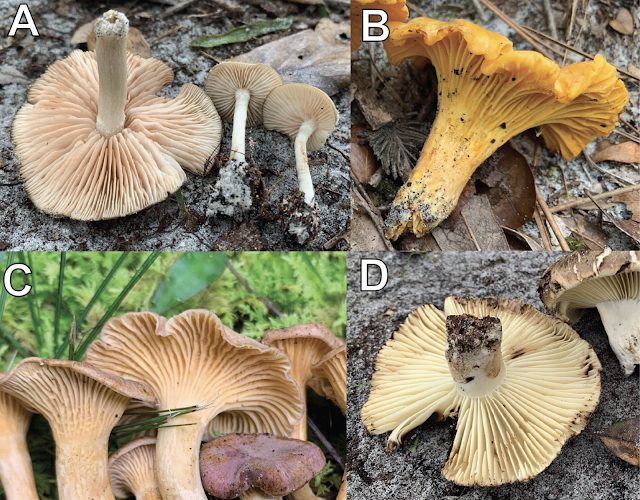蘑菇的作为真菌,在严谨学术里面分类繁复。但是在日常生活中,将蘑菇分为以下两大类是比较常用的方法,即简单易懂,又具有实用性。
第一类叫做 Nongilled Mushroom,就是没有褶皱(菌褶)的蘑菇。也就是看蘑菇伞头下面的有没有密密的褶皱。这类蘑菇大部分都没有毒。
而第二类 Gilled Mushroom 就是有菌褶的蘑菇。虽然常见的口菇/洋菇(white button mushroom)属于有菌褶蘑菇,但是大部分剧毒蘑菇都属于这一类,所以食用需谨慎。
一、无菌褶的蘑菇 Nongilled Mushroom
- Morel 羊肚菌
- Truffles 松露
- Chanterelles 鸡油菌
- Trumpets 喇叭菇
1. Black trumpets 黑喇叭菇
2. King Trumpets mushroom / King Oyster mushroom (Pleurotus eryngii)杏鲍菇
- Tooth Fungi(亚齿菌属):
1. Bear’s Head 猴头菇 2. Hedgehog(or Sweet Tooth)羊蹄菇 (刺猬/甜齿菇)
- Coral Fungi (珊瑚菌):
1. Sweet coral club 刷把菌,枝瑚菌,杵棒菌
2. Cauliflower mushroom 绣球菌,椰菜菌
3. Gamba Mushroom (Thelephora Gambajun) 干巴菌 (
全世界只有云南发现出产)- Boletes / Porcini 牛肝菌(黑牛肝、黄牛肝、白牛肝、红牛肝、黄癞头、见手青)
- Polypore 寬鱗多孔菌:
1. Chicken Mushrooms / chicken of the woods 鸡肉蘑菇/木头鸡肉2. Hen-of-the-Woods / Maitake 灰树花,舞茸
- Giant Puffball 马勃菌,马皮泡,牛眼睛菌 :
- Lobster Mushrooms 龙虾蘑菇
北美市场上常见到的这种较为高级的食用菇,虽然被称为龙虾菇,但其实不是一种蘑菇的类型,它是短柄白色的红菇 Short Stem Russula,被某种寄生菌感染以后,变成偏红的橘黄色。Russula(红菇 )虽然可以食用,但它本身并不好吃。但是当红菇被寄生变成龙虾菇后,就会变得好吃。
有趣的是,Russula(红菇 )是一种属于有菌褶的蘑菇,当成为龙虾菇以后,就变成了无菌褶蘑菇。同样的机制还有 Lactifluus (奶浆菌 milk cap mushroom)。
云南人常食用的一种叫做青头菌的蘑菇,它也都是红菇被不同寄生菌感染以后,转变而成的蘑菇。可是,青头菌依然是有菌褶蘑菇。
- Jelly Fungi :Wood-ears 木耳
二、有菌褶的蘑菇 Gilled Mushroom
- Agaricus Mushrooms 伞菌属蘑菇:
white button mushroom 白色口菇/洋菇
伞菌属蘑菇还有:PINK BOTTOM (Agaricus campestris) 、HORSE MUSHROOM (Agaricus arvensis)、THE PRINCE (Agaricus augustus)、SPRING AGARICUS (Agaricus bitorquis)
- Oyster Mushrooms 平菇
平菇虽然它的名字里也带了Oyster这个词,但是它不同于前面提到的 King Oyster Mushroom杏鲍菇。
- Honey Mushrooms 蜜环菌 , 榛蘑
- Shaggy Mane 鸡腿菇
也会被分类为inky cap的种类里面,当完全成熟以后,会开始变成黑色ink的状态。食用新鲜白色时候的蘑菇,避免变色的。
- Matsutakes 松茸
- Russula 红菇
Russula xerampelina (黄袍红菇)
其余红菇类别:Russula virescens (变绿红菇 青头菌)、赤黄红菇 (麦麸菌)Russula compacta Frost、黑红菇(火炭菌)Russula nigricans
- Milk Caps 奶浆菌,乳菇
1. orange milk cap (松乳菇、铜绿菌、谷熟菌、南瓜菌)(Lactarius deliciosus)2. Fish milk cap (Lactarius volemus) 多汁乳菇、奶浆菌、红奶浆菌
3. Candy cap (Lactarius rubidus)北美西海岸产
- Termite Mushrooms (Termitomyces Species) 鸡纵菌
*Why chanterelles are Nongilled mushroom*
One defining feature of chanterelle mushrooms is their blunt “false gills” that are decurrent (run down the stipe). These false gills are found on the underside of the cap, and are the part of the mushroom that produces microscopic spores. The “true gills” of other mushrooms can usually be plucked individually and resemble individual blades. In contrast, “false gills” cannot be individually plucked and do not move as freely—they are more like ridges than the true gills found in most other mushrooms. To test whether a mushroom has true gills or false gills, one may run a finger across the gills or try to pluck the blades. Some species of chanterelles have a completely smooth underside without any gills at all, or they may have false gills that are fused together (anastamosed), especially toward the edge of the cap.
Figure 1. A comparison between true gills and false gills:
. (A) True gills of an Entoloma species.
. (B) Decurrent and anastomosing (fusing) “false gills” of Cantharellus tenuithrix
. (C) The “false gills” of Cantharellus quercophilus
. (D) True gills of Russula nigricans




























Comments
Post a Comment